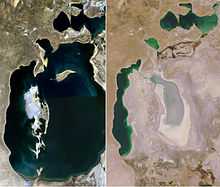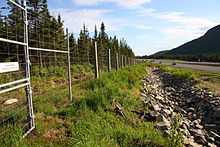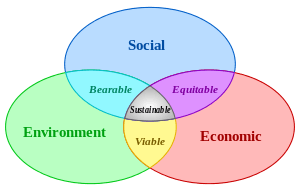Environmental resource management

Environmental resource management is the management of the interaction and impact of human societies on the environment. It is not, as the phrase might suggest, the management of the environment itself. Environmental resources management aims to ensure that ecosystem services are protected and maintained for future human generations, and also maintain ecosystem integrity through considering ethical, economic, and scientific (ecological) variables.[1] Environmental resource management tries to identify factors affected by conflicts that rise between meeting needs and protecting resources. It is thus linked to environmental protection and sustainability.
Significance
Environmental resource management is an issue of increasing concern, as reflected in its prevalence in seminal texts influencing global socio-political frameworks such as the Brundtland Commission's Our Common Future,[2] which highlighted the integrated nature of environment and international development and the Worldwatch Institute's annual State of the World (book series) reports.
The environment determines nature of every objects around the sphere. The behaviour, type of religion, culture and economic practices.
Scope
Environmental resource management can be viewed from a variety of perspectives. Environmental resource management involves the management of all components of the biophysical environment, both living (biotic) and non-living (abiotic). This is due to the interconnected and network of relationships amongst all living species and their habitats. The environment also involves the relationships of the human environment, such as the social, cultural and economic environment with the biophysical environment. The essential aspects of environmental resource management are ethical, economical, social, and technological. These underlie principles and help make decisions.
The concept of environmental determinism, probabilism and possibilism are significant in the concept of environmental reasource management.
It should be noted that environmental resource management covers many areas in the field of science: geography, biology, physics, chemistry, sociology, psychology, phisiology, etc.
Aspects
Ethical
Environmental resource management strategies are intrinsically driven by conceptions of human-nature relationships.[3] Ethical aspects involve the cultural and social issues relating to the environment, and dealing with changes to it. "All human activities take place in the context of certain types of relationships between society and the bio-physical world (the rest of nature),"[4] and so, there is a great significance in understanding the ethical values of different groups around the world. Broadly speaking, two schools of thought exist in environmental ethics: Anthropocentrism and Ecocentrism each influencing a broad spectrum of environmental resource management styles along a continuum.[3] These styles perceive "...different evidence, imperatives, and problems, and prescribe different solutions, strategies, technologies, roles for economic sectors, culture, governments, and ethics, etc."[4]
Anthropocentrism
Anthropocentrism, "...an inclination to evaluate reality exclusively in terms of human values,"[5] is an ethic reflected in the major interpretations of Western religions and the dominant economic paradigms of the industrialised world.[3] Anthropocentrism looks at nature as existing solely for the benefit of man, and as a commodity to use for the good of humanity and to improve human quality of life.[6][7][8] Anthropocentric environmental resource management is therefore not the conservation of the environment solely for the environment's sake, but rather the conservation of the environment, and ecosystem structure, for human sake.
Ecocentrism
Ecocentrists believe in the intrinsic value of nature while maintaining that human beings must use and even exploit nature to survive and live.[9] It is this fine ethical line that ecocentrists navigate between fair use and abuse.[9] At an extreme of the ethical scale, ecocentrism includes philosophies such as ecofeminism and deep ecology, which evolved as a reaction to dominant anthropocentric paradigms.[3] "In its current form, it is an attempt to synthesize many old and some new philosophical attitudes about the relationship between nature and human activity, with particular emphasis on ethical, social, and spiritual aspects that have been downplayed in the dominant economic worldview."[10]
Economic

The economy functions within, and is dependent upon goods and services provided by natural ecosystems.[11] The role of the environment is recognized in both classical economics and neoclassical economics theories, yet the environment held a spot on the back-burner of economic policies from 1950 to 1980 due to emphasis from policy makers on economic growth.[11] With the prevalence of environmental problems, many economists embraced the notion that, "If environmental sustainability must coexist for economic sustainability, then the overall system must [permit] identification of an equilibrium between the environment and the economy."[12] As such, economic policy makers began to incorporate the functions of the natural environment—or natural capital — particularly as a sink for wastes and for the provision of raw materials and amenities.[13] Debate continues among economists as to how to account for natural capital, specifically whether resources can be replaced through the use of knowledge and technology, or whether the economy is a closed system that cannot be replenished and is finite.[14] Economic models influence environmental resource management, in that management policies reflect beliefs about natural capital scarcity. For someone who believes natural capital is infinite and easily substituted, environmental management is irrelevant to the economy.[3] For example, economic paradigms based on neoclassical models of closed economic systems are primarily concerned with resource scarcity, and thus prescribe legalizing the environment as an economic externality for an environmental resource management strategy.[3] This approach has often been termed 'Command-and-control'.[3] Colby has identified trends in the development of economic paradigms, among them, a shift towards more ecological economics since the 1990s.[3]
Ecological


"The pairing of significant uncertainty about the behaviour and response of ecological systems with urgent calls for near-term action constitutes a difficult reality, and a common lament" for many environmental resource managers.[15] Scientific analysis of the environment deals with several dimensions of ecological uncertainty.[16] These include: structural uncertainty resulting from the misidentification, or lack of information pertaining to the relationships between ecological variables; parameter uncertainty referring to "uncertainty associated with parameter values that are not known precisely but can be assessed and reported in terms of the likelihood…of experiencing a defined range of outcomes";[17] and stochastic uncertainty stemming from chance or unrelated factors.[16] Adaptive management [18][19] is considered a useful framework for dealing with situations of high levels of uncertainty [20] though it is not without its detractors.[21]
A common scientific concept and impetus behind environmental resource management is carrying capacity. Simply put, carrying capacity refers to the maximum number of organisms a particular resource can sustain. The concept of carrying capacity, whilst understood by many cultures over history, has its roots in Malthusian theory. An example is visible in the EU Water Framework Directive. However, "it is argued that Western scientific knowledge ... is often insufficient to deal with the full complexity of the interplay of variables in environmental resource management.[22][23] These concerns have been recently addressed by a shift in environmental resource management approaches to incorporate different knowledge systems including traditional knowledge,[24] reflected in approaches such as adaptive co-management [25][26][27] community-based natural resource management [28][29] and transitions management.[30] among others.[24]
Sustainability
Sustainability and environmental resource management involves managing economic, social, and ecological systems within and external to an organizational entity so it can sustain itself and the system it exists in.[31][32] In context, sustainability implies that rather than competing for endless growth on a finite planet, development improves quality of life without necessarily consuming more resources.[33] Sustainably managing environmental resources requires organizational change that instills sustainability values that portrays these values outwardly from all levels and reinforces them to surrounding stakeholders.[31][32] The end result should be a symbiotic relationship between the sustaining organization, community, and environment.
Many drivers compel environmental resource management to take sustainability issues into account. Today's economic paradigms do not protect the natural environment, yet they deepen human dependency on biodiversity and ecosystem services.[34] Ecologically, massive environmental degradation [35][36] and climate change [37][38] threaten the stability of ecological systems that humanity depends on.[32][39] Socially, an increasing gap between rich and poor and the global North-South divide denies many access to basic human needs, rights, and education, leading to further environmental destruction.[32][39][40][41] The planet's unstable condition is caused by many anthropogenic sources.[37] As an exceptionally powerful contributing factor to social and environmental change, the modern organisation has the potential to apply environmental resource management with sustainability principals to achieve highly effective outcomes.[31][32] To achieve sustainable development with environmental resource management an organisation should coincide with sustainability principles, such as: social and environmental accountability, long-term planning; a strong, shared vision; a holistic focus; devolved and consensus decision making; broad stakeholder engagement and justice; transparency measures; trust; and flexibility, to name a few.[31][32][42]
Current paradigm shifts
To adjust to today's environment of quick social and ecological changes, some organizations have begun to experiment with various new tools and concepts.[43][44] Those that are more traditional and stick to hierarchical decision making have difficulty dealing with the demand for lateral decision making that supports effective participation.[43] Whether it be a matter of ethics or just strategic advantage organizations are internalizing sustainability principles.[44][45] Examples of some of the world's largest and most profitable corporations who are shifting to sustainable environmental resource management are: Ford, Toyota, BMW, Honda, Shell, Du Pont, Swiss Re, Hewlett-Packard, and Unilever.[31][32] An extensive study by the Boston Consulting Group reaching 1,560 business leaders from diverse regions, job positions, expertise in sustainability, industries, and sizes of organizations, revealed the many benefits of sustainable practice as well as its viability.[45]
It is important to note that though sustainability of environmental resource management has improved,[31][32] corporate sustainability, for one, has yet to reach the majority of global companies operating in the markets.[42] The three major barriers to preventing organizations to shift towards sustainable practice with environmental resource management are: not understanding what sustainability is; having difficulty modeling an economically viable case for the switch; and having a flawed execution plan, or a lack thereof.[45] Therefore the most important part of shifting an organization to adopt sustainability in environmental resource management would be to create a shared vision and understanding of what sustainability is for that particular organization, and to clarify the business case.[45]
Stakeholders
Public sector

The public sector comprises the general government sector plus all public corporations including the central bank.[46] In environmental resource management the public sector is responsible for administering natural resource management and implementing environmental protection legislation.[47] The traditional role of the public sector in environmental resource management is to provide professional judgement through skilled technicians on behalf of the public.[43] With the increase of intractable environmental problems, the public sector has been led to examine alternative paradigms for managing environmental resources.[43] This has resulted in the public sector working collaboratively with other sectors (including other governments, private and civil) to encourage sustainable natural resource management behaviours.[47]
Private sector
The private sector comprises private corporations and non-profit institutions serving households.[48] The private sector's traditional role in environmental resource management is that of the recovery of natural resources.[49] Such private sector recovery groups include mining (minerals and petroleum), forestry and fishery organisations.[49] Environmental resource management undertaken by the private sectors varies dependent upon the resource type, that being renewable or non-renewable and private and common resources (also see Tragedy of the Commons).[49] Environmental managers from the private sector also need skills to manage collaboration within a dynamic social and political environment.[43]
Civil society
Civil society comprises associations in which societies voluntarily organise themselves into and which represent a wide range of interests and ties.[50] These can include community-based organisations, indigenous peoples' organisations and non-government organisations (NGO).[50] Functioning through strong public pressure, civil society can exercise their legal rights against the implementation of resource management plans, particularly land management plans.[43] The aim of civil society in environmental resource management is to be included in the decision-making process by means of public participation.[43] Public participation can be an effective strategy to invoke a sense of social responsibility of natural resources.[43]
Tools
As with all management functions, effective management tools, standards and systems are required. An environmental management standard or system or protocol attempts to reduce environmental impact as measured by some objective criteria. The ISO 14001 standard is the most widely used standard for environmental risk management and is closely aligned to the European Eco-Management and Audit Scheme (EMAS). As a common auditing standard, the ISO 19011 standard explains how to combine this with quality management.
Other environmental management systems (EMS) tend to be based on the ISO 14001 standard and many extend it in various ways:
- The Green Dragon Environmental Management Standard is a five level EMS designed for smaller organisations for whom ISO 14001 may be too onerous and for larger organisations who wish to implement ISO 14001 in a more manageable step-by-step approach,[51]
- BS 8555 is a phased standard that can help smaller companies move to ISO 14001 in six manageable steps,
- The Natural Step focuses on basic sustainability criteria and helps focus engineering on reducing use of materials or energy use that is unsustainable in the long term,
- Natural Capitalism advises using accounting reform and a general biomimicry and industrial ecology approach to do the same thing,
- US Environmental Protection Agency has many further terms and standards that it defines as appropriate to large-scale EMS,
- The UN and World Bank has encouraged adopting a "natural capital" measurement and management framework,
- The European Union Eco-Management and Audit Scheme (EMAS).
Other strategies exist that rely on making simple distinctions rather than building top-down management "systems" using performance audits and full cost accounting. For instance, Ecological Intelligent Design divides products into consumables, service products or durables and unsaleables — toxic products that no one should buy, or in many cases, do not realize they are buying. By eliminating the unsaleables from the comprehensive outcome of any purchase, better environmental resource management is achieved without systems.
Recent successful cases have put forward the notion of integrated management. It shares a wider approach and stresses out the importance of interdisciplinary assessment. It is an interesting notion that might not be adaptable to all cases.[52]
Journals
- Clean Technologies and Environmental Policy, ISSN 1618-954X
- Corporate Social Responsibility and Environmental Management, ISSN: 1535-3966 (electronic) 1535-3958 (paper), John Wiley & Sons
- Environmental Management, Springer Science+Business Media
- Environmental Practice, ISSN: 1466-0474 (electronic) 1466-0466 (paper), Cambridge University Press
- Environmental Quality Management, ISSN: 1520-6483 (electronic) 1088-1913 (paper), John Wiley & Sons
- Journal of Environmental Economics and Management
- Journal of Environmental Planning and Management, ISSN: 1360-0559 (electronic) 0964-0568 (paper), Routledge
- Journal of Environmental Management, ISSN: 0301-4797, Elsevier
- Environmental Values
See also
References
- ↑ Pahl-Wost, C. (May 2007). "The implications of complexity for integrated resource management". Environmental Modelling and Software 22 (5): 561–9. doi:10.1016/j.envsoft.2005.12.024.:561
- ↑ World Commission on Environment and Development (2 August 1987). "Our Common Future, Report of the World Commission on Environment and Development". Development and International Co-operation: Environment. United Nations. General Assembly document A/42/427.
- ↑ 3.0 3.1 3.2 3.3 3.4 3.5 3.6 3.7 Colby, M.E. (September 1991). "Environmental management in development: the evolution of paradigms". Ecological Economics 3 (3): 193–213. doi:10.1016/0921-8009(91)90032-A.
- ↑ 4.0 4.1 Colby 1991, p. 193
- ↑ "Anthropocentrism". WordNet Search — 3.1. Princeton University.
- ↑ White L (March 1967). "The historical roots of our ecologic crisis". Science 155 (3767): 1203–7. doi:10.1126/science.155.3767.1203. PMID 17847526.
- ↑ Berman, Morris (1981). The Reenchantment of the World. Cornell University Press. ISBN 978-0-8014-9225-9. Retrieved 31 October 2013.
- ↑ Pepper, David; Perkins, John W.; Youngs, Martyn J. (1984). The Roots of Modern Environmentalism. Croom Helm. ISBN 978-0-7099-2064-9.
- ↑ 9.0 9.1 Purser, R.; Montuori, A. (July 1996). "Ecocentrism is in the eye of the beholder" (PDF). Acad. Manage. Rev. 21: 611–3. doi:10.5465/AMR.1996.26115125.:611
- ↑ Colby 1991, p. 199
- ↑ 11.0 11.1 Thampapillai, Dodo J. (2002). Environmental economics: concepts, methods, and policies. Oxford University Press. ISBN 978-0-19-553577-8.
- ↑ Thampapillai 2002, p. 21
- ↑ Kneese, Allen V.; Ayres, Robert U.; D'Arge, Ralph C. (1970). Economics and the environment: a materials balance approach. Resources for the Future; distributed by the Johns Hopkins Press, Baltimore. ISBN 978-0-8018-1215-6.
- ↑ Daly, Herman E.; Cobb, John B. Jr (1994). For The Common Good: Redirecting the Economy toward Community, the Environment, and a Sustainable Future. Beacon Press. ISBN 978-0-8070-4705-7.
- ↑ Arvai, Gregory & Ohlson 2006, p. 2413
- ↑ 16.0 16.1 Arvai, J.; Gregory, R.; Ohlson, D. (December 2006). "Deconstructing Adaptive Management: Criteria for Applications to Environmental Management". Ecological Applications 16 (6): 2411–25. doi:10.1890/1051-0761(2006)016[2411:DAMCFA]2.0.CO;2. PMID 17205914.
- ↑ Arvai, Gregory & Ohlson 2006, p. 2417
- ↑ Walters, Carl J. (1986). Adaptive management of renewable resources. Macmillan. ISBN 978-0-02-947970-4.
- ↑ United Nations Environment Programme (1978). Holling, C.S., ed. Adaptive environmental assessment and management. International Institute for Applied Systems Analysis. ISBN 978-0-471-99632-3.
- ↑ Gunderson, Lance H.; Holling, C.S., eds. (2002). Panarchy Synopsis: Understanding Transformations in Human and Natural Systems. Island Press. ISBN 978-1-55963-330-7.
- ↑ Walters C; Holling CS. (December 1990). "Large-scale management experiments and learning by doing". Ecology 71 (6): 2060–8. doi:10.2307/1938620.
- ↑ Johannes RE (June 1998). "The case for data-less marine resource management: examples from tropical nearshore finfisheries". Trends Ecol. Evol. (Amst.) 13 (6): 243–6. doi:10.1016/S0169-5347(98)01384-6. PMID 21238285.
- ↑ Ludwig, D.; Mangel, M.; Haddad, B. (November 2001). "Ecology, conservation, and public policy". Annual Review of Ecological Systems 32: 481–571. doi:10.1146/annurev.ecolsys.32.081501.114116.
- ↑ 24.0 24.1 Raymond CM, Fazey I, Reed MS, Stringer LC, Robinson GM, Evely AC (August 2010). "Integrating local and scientific knowledge for environmental management". J. Environ. Manage. 91 (8): 1766–77. doi:10.1016/j.jenvman.2010.03.023. PMID 20413210.
- ↑ Folke, C.; Hahn, T.; Olsson, P.; Nordberg, J. (November 2005). "Adaptive governance of social-ecological systems". Annual Review of Environment and Resources 30: 441–473. doi:10.1146/annurev.energy.30.050504.144511.
- ↑ Armitage, D.R.; Berkes, F.; Doubleday, N. (2007). Adaptive Co-Management: Collaboration, Learning, and Multi-Level Governance. Vancouver: UBC Press. ISBN 978-0-7748-1383-9.
- ↑ Berkes F (April 2009). "Evolution of co-management: role of knowledge generation, bridging organizations and social learning". J. Environ. Manage. 90 (5): 1692–702. doi:10.1016/j.jenvman.2008.12.001. PMID 19110363.
- ↑ Kellert, S.R.; Mehta, J.N.; Ebbin, S.A.; Lichtenfeld, L.L. (2000). "Community natural resource management: promise, rhetoric and reality". Society and Natural Resources 13 (8): 705–715. doi:10.1080/089419200750035575.
- ↑ Blaikie, P. (November 2006). "Is small really beautiful? Community-based natural resource management in Malawi and Botswana". World Development 34 (11): 1942–57. doi:10.1016/j.worlddev.2005.11.023.
- ↑ Geels, F.W. (December 2002). "Technological transitions as evolutionary reconfiguration processes: a multi-level perspective and a case-study". Research Policy 31 (8–9): 1257–74. doi:10.1016/S0048-7333(02)00062-8.
- ↑ 31.0 31.1 31.2 31.3 31.4 31.5 Avery, Gayle C.; Bergsteiner, Harald (2010). Honeybees and Locusts: The Business Case for Sustainable Leadership. Allen & Unwin. ISBN 978-1-74237-393-5.
- ↑ 32.0 32.1 32.2 32.3 32.4 32.5 32.6 32.7 Dunphy, Dexter Colboyd; Griffiths, Andrew; Ben, Suzanne (2007). Organizational Change for Corporate Sustainability: A Guide for Leaders and Change Agents of the Future (2nd ed.). Taylor & Francis.
- ↑ Costanza, Robert (1991). Ecological Economics: The Science and Management of Sustainability. Columbia University Press. ISBN 978-0-231-07563-3.
- ↑ Guo Z, Zhang L, Li Y (2010). "Increased dependence of humans on ecosystem services and biodiversity". PLoS ONE 5 (10). doi:10.1371/journal.pone.0013113. PMC 2948508. PMID 20957042.
- ↑ Costanza, Robert; Norton, Bryan G.; Haskell, Benjamin D. (1992). Ecosystem Health: New Goals for Environmental Management. Island Press. ISBN 978-1-55963-140-2.
- ↑ "Environment Management Group: Biodiversity". UNEP 1 2010. UNEP. 10 August 2011.
- ↑ 37.0 37.1 IPCC AR4 SYR (2007). Core Writing Team; Pachauri, R.K; and Reisinger, A., ed. Climate Change 2007: Synthesis Report. Contribution of Working Groups I, II and III to the Fourth Assessment Report of the Intergovernmental Panel on Climate Change. IPCC. pp. 1–22. ISBN 92-9169-122-4.
- ↑ Oreskes N (December 2004). "Beyond the ivory tower. The scientific consensus on climate change". Science 306 (5702): 1686. doi:10.1126/science.1103618. PMID 15576594.
- ↑ 39.0 39.1 UNEP United Nations Environmental Program, 2002, "Integrating Environment and Development: 1972 – 2002", United Nations.
- ↑ Barkin, D. (1998). "Riqueza, Pobreza y Desarrollo Sustentable". Mexico: Editorial Jus y Centro de Ecologia y Desarrollo.
- ↑ "Poverty Reduction and Equity". The World Bank. 10 September 2011.
- ↑ 42.0 42.1 UN Global Compact 2010, 'Blueprint for Corporate Sustainability Leadership', "UN Global Compact", UN Global Compact Office, Pp 2 – 12.
- ↑ 43.0 43.1 43.2 43.3 43.4 43.5 43.6 43.7 Selin. S.; Chavez. D. (March–April 1995). "Developing a Collaborative Model for Environmental Planning and Management". Environmental Management 19 (2): 189–195. doi:10.1007/BF02471990.
- ↑ 44.0 44.1 Daily, B.F.; Huang, S. (2001). "Achieving sustainability through attention to human resource factors in environmental management". International Journal of Operations & Production Management 21 (12): 1539–52. doi:10.1108/01443570110410892.
- ↑ 45.0 45.1 45.2 45.3 Berns, M.; Townend, A.; Khayat, Z.; Balagopal, B.; Reeves, M.; Hopkins, M.; Kruschqwitz, N. (2009). "The Business of Sustainability: Imperatives, Advantages, and Actions" (PDF). Boston Consulting Group Report. pp. 4–32.
- ↑ Organisation for Economic Co-operation and Development (OECD), 2006, Glossary of Statistical Terms: Public Sector. Retrieved 23 September 2011.
- ↑ 47.0 47.1 The State of Queensland: Department of Environment and Resource Management (DERM), 2011, What we do. Retrieved 23 September 2011.
- ↑ Organisation for Economic Co-operation and Development (OECD), 2001, Glossary of Statistical Terms: Private Sector, Retrieved 23 September 2011.
- ↑ 49.0 49.1 49.2 Smith, V.L. (June 1968). "Economics of Production from Natural Resources". American Economic Review 58 (3 Part 1): 409–413. JSTOR 1813767.
- ↑ 50.0 50.1 Organisation for Economic Co-operation and Development (OECD), 2007, Glossary of Statistical Terms: Civil Society Organisations. Retrieved 23 September 2011.
- ↑ "Green Dragon Environmental Standard". Groundwork UK. Retrieved 24 September 2011.
- ↑ Billé, R. (2008). "Integrated Coastal Zone Management: four entrenched illusions". S.A.P.I.EN.S. 1 (2).
Further reading
- Schaltegger, Stefan; Burritt, Roger; Petersen, Holger (2003). An Introduction to Corporate Environmental Management: Striving for Sustainability. Greenleaf. ISBN 978-1-874719-65-6.
- Low Hock Heng (2003). "Globalisation, Business and Environmental Management: to Correct the Broken Compass?" (PDF). Jurnal Kemanusiaan. ISSN 1675-1930.
External links
- Economic Costs & Benefits of Environmental Management NOAA Economics
- business.gov — provides businesses with environmental management tips, as well as tips for green business owners] (United States)
| |||||||||||||||||||||
